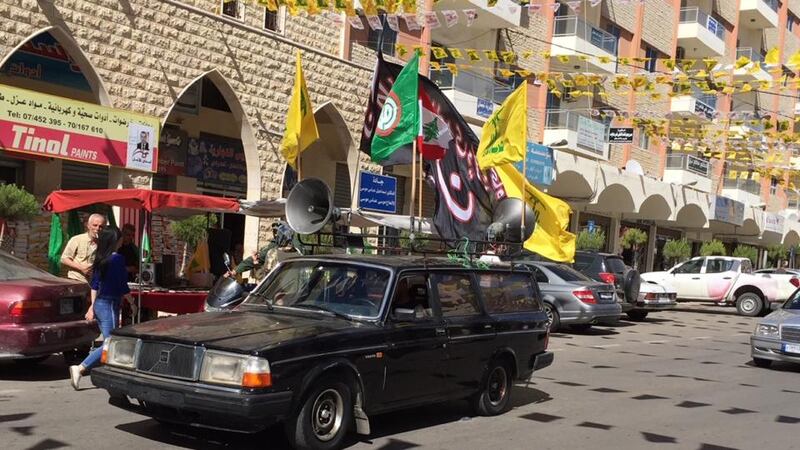The eastern route through south Lebanon winds through green hills shrouded in damp, dusty mist. Brush, carob and olive trees climb the slopes, flowering mimosa graces roadsides.
Israel's whitewashed wall at the village of Kafr Kila is decorated with bright graffiti, both political and personal. From photographs posted on the wall, the eyes of slain Hizbullah and Amal fighters and local civilians assess visitors and track passing vehicles. They died in the campaign to drive Israeli occupation forces from the south.
Martyrs' visages are given pride of place in memorials in villages and towns all along the Blue Line drawn by the UN in 2000 to demonstrate Israel had withdrawn fully from Lebanese territory. Beirut disputes the line, claiming pockets of land belonging to Lebanon remain in Israeli hands but does nothing to regain them.
UN force spokesman Andrea Tenenti says the "last 12 years" of the peacekeeping mission have been the "quietist period". Today, there are 10,500 troops from 41 countries deployed in this small, but strategically significant slice of Lebanon. He does not expect the situation to change in spite of rising tension due to threats by Israel's right-wing government against Iran and its ally, Lebanon's Hizbullah movement, the most powerful political and military force in the south.
Villages levelled during Israel's devastating 2006 war on Hizbullah have risen from the rubble. Homes, shops, and municipal offices were reconstructed with Saudi, Kuwaiti, Emirati and Iranian money. Rapprochement among donors has since turned to hostility thanks to the rivalry of regional Sunni powers with Shia Iran and its allies here, in Syria and Iraq.
'Interim' has become forever. Ireland was among the first to deploy. On May 13th, a modest ceremony marked 40 years of the mission
Hilltops are dominated by luxurious stone-block villas with red-tile roofs built by wealthy Shias determined to defy Israel’s might. Farmers plant crops of tobacco and vegetables up to the Blue Line to express “resistance” to Israel’s presence on the other side.
UN scout cars
Two white UN armoured scout cars carrying peace soldiers are parked on a side road. South Lebanon has been a war zone since Israel’s establishment in 1948. Land, water, and security are hard-fought issues for both sides.

In 1978, the UN established an “interim” peace force (Unifil) to discourage warfare. “Interim” has become forever. Ireland was among the first to deploy. On May 13th, a modest ceremony marked 40 years of the mission.
Today, 336 Irish peacekeepers, including 17 women, serve in the western zone alongside 171 Finns and 36 Estonians. Their base is at-Tir near Bint Jbeil, known as the “capital of the resistance” because the village did not fall to invading Israelis in 2006.
Irish contingent commander Lieut Col Neil Nolan tells The Irish Times the mission operates in a 111sq km area containing 11 Shia and two Christian villages and one mixed village. There are also 3,000 Sunni Syrian refugees living in houses and flats; most of the men are farm labourers.
“The situation is calm [despite] latent tension,” he says. Both sides are “very cognisant of the fact our area is susceptible . . . Matters can change very quickly.” Peacekeepers patrol both on foot and in vehicles. “We report everything . . . what we see and hear, overflights and activities on the ground.”
Lebanese families picnic under shelters. Men grill fragrant kebabs over charcoal. Women in headscarves and flowing cloaks sit and chat
The UN brokers trilateral weekly meetings involving Lebanese and Israeli army officers to resolve problems. While military forces exert “hard power”, he says, peacekeepers provide “soft power” by cultivating civilians in operational areas and carrying out humanitarian projects. First aid, money awareness and female self-defence classes “build trust and increase understanding and resilience of local communities”.
Israeli settlements
Irish peacekeepers must not only adjust to the culture of the local people but also bridge cultural differences with Finnish and Estonian colleagues and train Lebanese troops destined, eventually, to assume full control of the south.
Every day is a holiday at Iran Garden, Tehran’s gift to the village of Maroun al-Ras. The site commands a ridge above northern Israel. The view is of verdant Israeli fields stretching back from the line to settlements planted at some distance.
Lebanese families picnic under shelters. Men grill fragrant kebabs over charcoal. Women in headscarves and flowing cloaks sit and chat. Children armed with ice cream cones rush along pathways edged by beds of flowers and shrubs.
The garden’s golden-domed mosque is a tiny replica of Jerusalem’s elegant seventh-century Muslim shrine, the Dome of the Rock, a site of continuing dispute. Even parks are political in south Lebanon.
On a tree-studded hill near Tibnin, the Irish battalion’s former base, another garden has been dedicated to the 47 Irish troops killed while keeping the peace. A gleaming black granite monument with the names of the slain catches afternoon light and shadow. This is a land of martyrs made by war and martyrs seeking peace.











